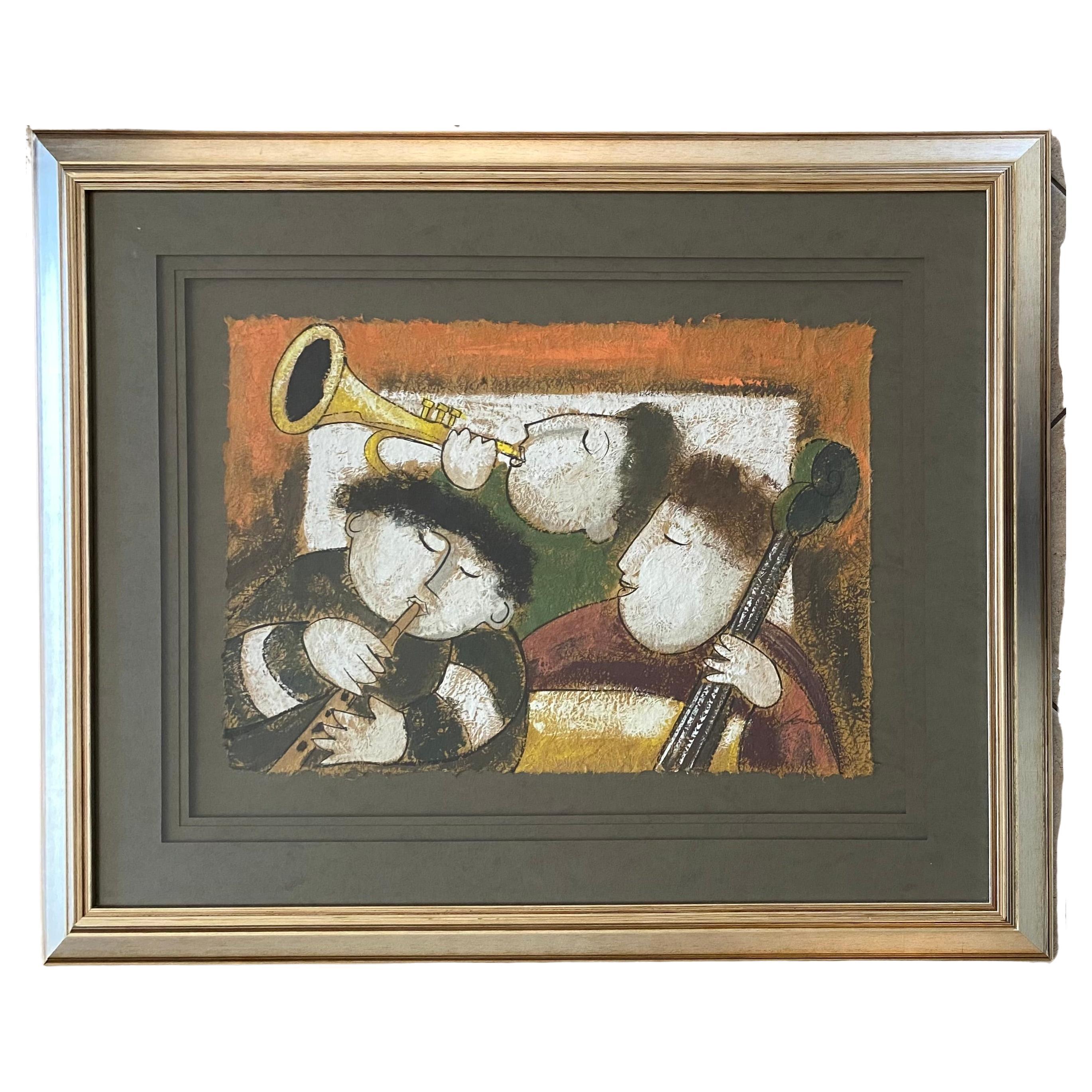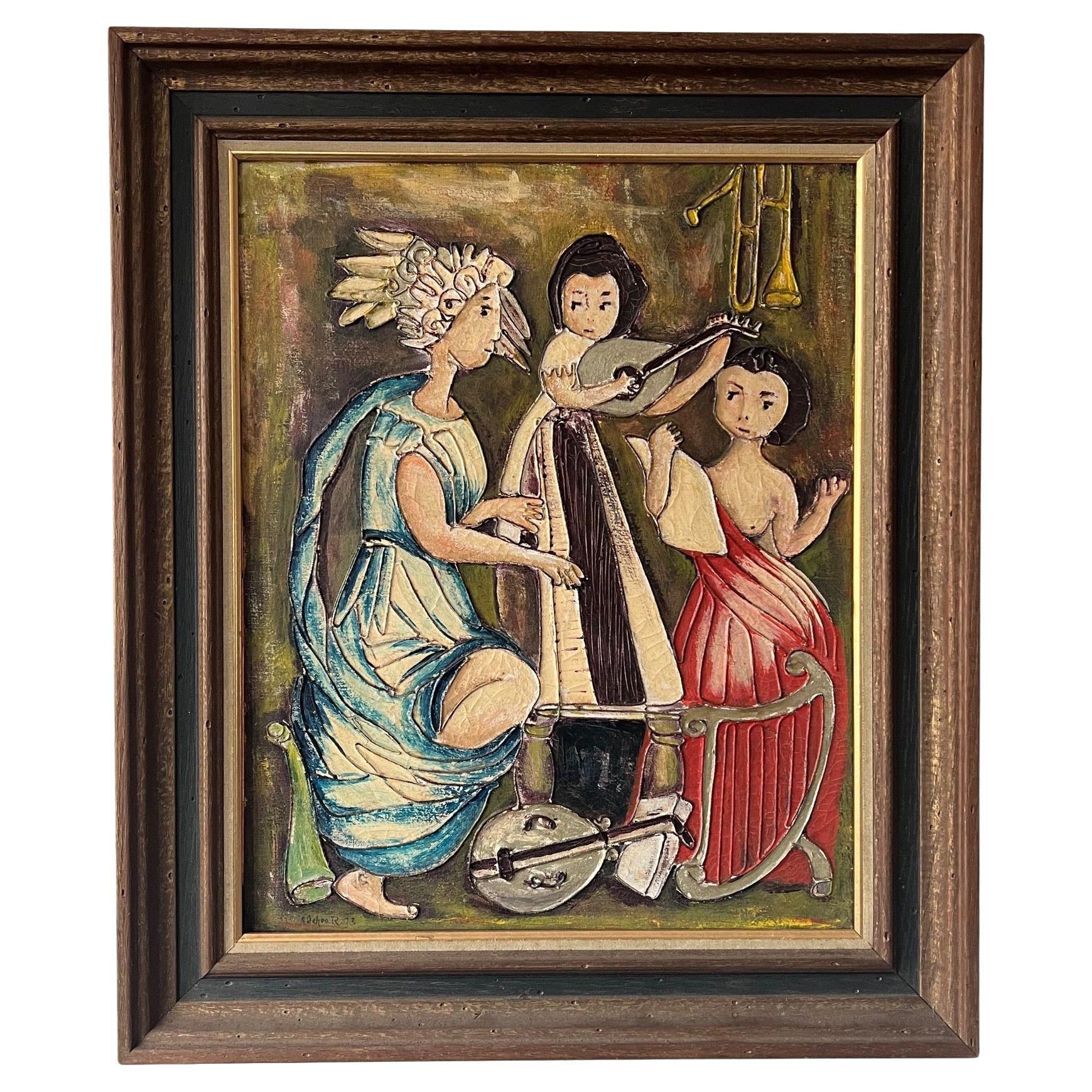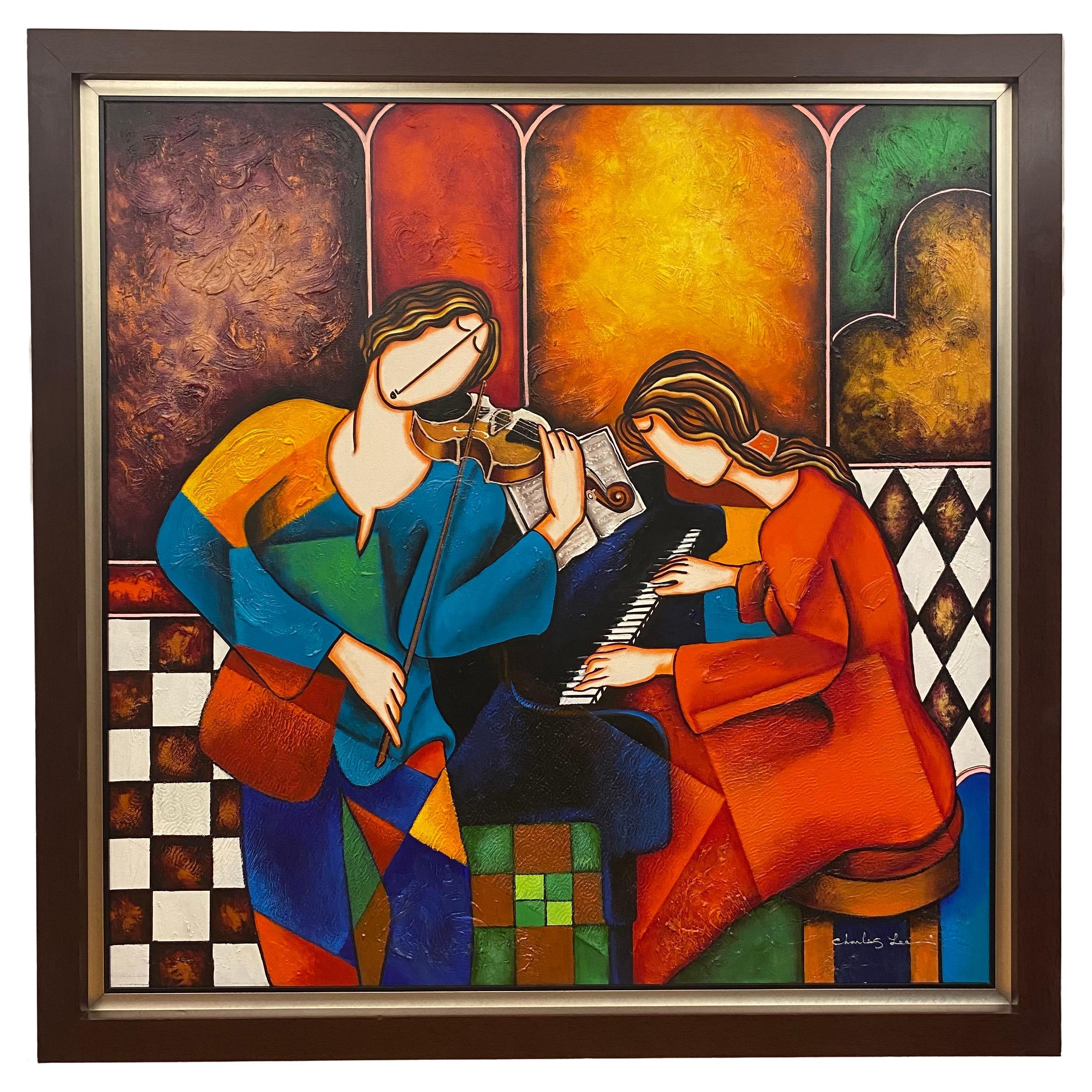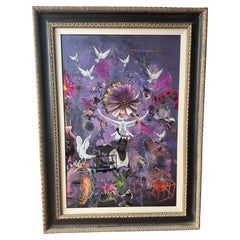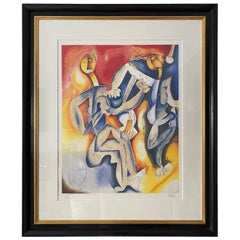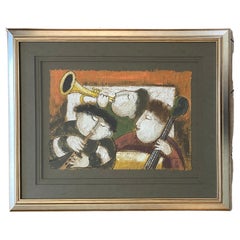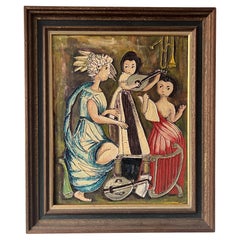Items Similar to Joyce Roybal – "Trumpet Players" – Original Oil Painting with Ornate Frame
Video Loading
Want more images or videos?
Request additional images or videos from the seller
1 of 10
Joyce Roybal – "Trumpet Players" – Original Oil Painting with Ornate Frame
$2,100
£1,593.43
€1,821.95
CA$2,933.13
A$3,261.24
CHF 1,702.84
MX$39,697.26
NOK 21,727.51
SEK 20,357.63
DKK 13,597.52
Shipping
Retrieving quote...The 1stDibs Promise:
Authenticity Guarantee,
Money-Back Guarantee,
24-Hour Cancellation
About the Item
This whimsical and vibrant painting by Joyce Roybal captures her signature style of joyful, childlike wonder. Featuring three stylized figures playing trumpets, the composition is rich in both movement and character. Each figure, with its elongated limbs and expressive posture, contributes to a scene that feels both theatrical and musical. The textured brushwork and warm palette evoke a playful atmosphere, while the unique proportions and curved forms reflect Roybal’s distinctive visual language.
Executed in oil on canvas, the painting is beautifully complemented by an elaborate, antique-style gilded frame that adds a sense of grandeur and sophistication to the piece. This artwork is a quintessential example of Roybal’s talent for blending the fantastical with the innocent, resulting in a timeless piece that appeals to collectors of modern and naïve art alike.
Joyce Roybal is a celebrated French artist best known for her imaginative figures and lighthearted subject matter. Her work often focuses on musicians, dancers, and circus scenes, rendered in a whimsical style that draws comparisons to Marc Chagall and the naïve art tradition. Roybal's paintings have found homes in galleries and private collections across Europe and North America, making her a beloved name among art enthusiasts seeking charm and originality.
A delightful and collectible artwork, perfect for adding color and personality to any space.Frame size is 22“ x 26 1/2“" x Artwork 12 inches wide by 16 inches tall"
- Similar to:Graciela Rodo Boulanger (Artist)
- Dimensions:Height: 26.5 in (67.31 cm)Width: 22 in (55.88 cm)Depth: 3 in (7.62 cm)
- Materials and Techniques:
- Period:
- Date of Manufacture:circa 1970
- Condition:
- Seller Location:New York City, NY
- Reference Number:1stDibs: LU5191144646982
Farrago Design Inc
Farrago Design is a New York–based design studio creating collectible furniture and home accessories that marry craftsmanship with contemporary design. Founded with a mission to revive traditional techniques in a modern context, Farrago works directly with artisans to create heirloom-quality pieces using materials such as hand-carved bone, horn, sand-cast metals, and semi-precious stones. Our work sits at the crossroads of art and function and includes three collections. The Sand Collection features intricately hand-cut bone and horn inlays set into wood and sealed with a water-based resin. The patterns—subtle, organic, and architectural—are fully customizable, making these pieces ideal for bespoke residential and hospitality projects.
The Water Collection explores the sculptural potential of metal, using sand-casting techniques to create fluid, one-of-a-kind forms in Bronze, Aluminum, Brass etc, From side tables to lighting, each piece is cast in a single-use mold, making it truly unique adding texture and movement.
The Earth Collection celebrates the raw beauty of the natural world, incorporating hand-set minerals like pyrite, selenite, and semi-precious stones into bold, luxurious designs. Every piece is made to order and can be customized in scale, material, and finish. We welcome trade inquiries and collaborate closely with designers to develop bespoke products whether for a modern loft, boutique hotel, or superyacht interior.
About the Seller
5.0
Gold Seller
Premium sellers maintaining a 4.3+ rating and 24-hour response times
Established in 2003
1stDibs seller since 2020
12 sales on 1stDibs
- ShippingRetrieving quote...Shipping from: New York, NY
- Return Policy
Authenticity Guarantee
In the unlikely event there’s an issue with an item’s authenticity, contact us within 1 year for a full refund. DetailsMoney-Back Guarantee
If your item is not as described, is damaged in transit, or does not arrive, contact us within 7 days for a full refund. Details24-Hour Cancellation
You have a 24-hour grace period in which to reconsider your purchase, with no questions asked.Vetted Professional Sellers
Our world-class sellers must adhere to strict standards for service and quality, maintaining the integrity of our listings.Price-Match Guarantee
If you find that a seller listed the same item for a lower price elsewhere, we’ll match it.Trusted Global Delivery
Our best-in-class carrier network provides specialized shipping options worldwide, including custom delivery.More From This Seller
View All"La Salute" Cityscape by Lazzaro Donati - Oil on Board
By Lazzaro Donati
Located in New York City, NY
"La Salute" is a striking oil painting by renowned Italian artist Lazzaro Donati, depicting the iconic Santa Maria della Salute church in Venice. Known for his vivid, expressionistic...
Category
Vintage 1960s Italian Paintings
Materials
Paint
Hilary Opperman Mixed Media Collage: "Angels upon Us"
By Richard Hamilton
Located in New York City, NY
This captivating mixed media artwork by Hilary Opperman masterfully combines collage techniques with painting to create a vibrant dreamscape dominated by lush purples and pinks. The ...
Category
2010s Modern Contemporary Art
Materials
Paint, Paper
O/C Mid-Century Abstract Figurative Painting, Signed and Dated
By Wifredo Lam
Located in New York City, NY
This striking mid-century abstract painting depicts a seated dancer rendered in a sophisticated cubist-inspired style reminiscent of Pei Yang's work, though attribution remains uncon...
Category
Mid-20th Century Paintings
Materials
Paint
Alexandra Nechita "Your Guitar My Music" Hand Signed Ltd Ed Lithograph-Framed
By (after) Pablo Picasso
Located in New York City, NY
Alexandra Nechita "Your Guitar my music" 1997 Print - Lithograph on handpulled on Archival Paper in Paris 41.5'' x 34.5'' in Paris. Edition: Signed in pencil and marked 131/250 From ...
Category
Late 20th Century Contemporary Art
Materials
Paper, Paint
Large Modern Abstract Art Painting Signed Original Mark Dickson
By (after) Mark Rothko
Located in New York City, NY
This is an Original Mark Dickson painting and can be described as nothing short of a revelation in the realm of contemporary art. As one navigates through his vibrant interplay of colors—pinks, purples, blues, and greens—it becomes evident that his works are a bridge between abstract expression and a deep-seated Coloradan sensibility.
From afar, the paintings resonate with the raw energy and abstract impulsiveness reminiscent of Adolph Gottlieb or Mark Rothko. However, upon closer introspection, Dickson's canvas unfolds a symphony, harmoniously blending his intuitive understanding of the Colorado landscapes with an almost Rothkoesque play of color and form.
His artistry is a culmination of his academic sojourns, from the bustling art scene of Brooklyn's Pratt Institute to the scholarly corridors of the University of Denver. Yet, what stands out is his capability to transcend these teachings and manifest a unique narrative—one that reflects both the external world and the myriad landscapes of the human psyche.
The choice of medium, notably pastel mixed with watercolors, oil washes, and graphite pencil, demonstrates a tactile indulgence in his craft. It's as if he's chiseling his memories, experiences, and observations of the Coloradan terrains and skies into each canvas.
For the discerning eye, his works might also evoke the expansive color fields of Milton Avery. Yet, Dickson’s approach, particularly his relationship with color, is refreshingly instinctual, almost challenging the viewer to feel rather than dissect.
In Mark Dickson's work, we're treated to an exhilarating dance of abstract brilliance juxtaposed with the tangible and intangible memories of Colorado's landscapes. In a sense, each painting becomes an invitation—to wander, to wonder, and to immerse in the art of profound introspection.
The majority medium is pastel and a mixed media of watercolors, oil washes, and graphite pencil. Color is of primary importance to his work. His work shows the influence of artists Milton Avery(who used large areas of color) and Mark Rothko and Adolph Gottlieb (known for their work in the variations of color). Mark is fascinated with color and explores every aspect of its relationships. He feels his use of color is more intuitive versus analytical.
Mark Dickson’s paintings, prints and monotypes are represented in private, corporate and public art collections nationally.
Pratt Institute, Graduate School of Fine Arts, Brooklyn, New York, 1970
University of Denver, Graduate School of Art, MFA, Denver, Brooklyn, New York, 1973
Denver Art Museum, Colorado Annual, 1967
National Academy of Design, National Audubon Exhibition, New York
Joslin Art Museum Exhibition of Colorado artists, Omaha, Nebraska
Included in Outstanding and Noteworthy Americans, Bicentennial Edition, New York
Chicago Botanical Garden, solo exhibition, North Brook Illinois
Colorado Symphony Orchestra Association, limited-edition lithograph commission
Broadway South West department store Commission; shopping bag and print.
Award of Merit from American Institute of graphic arts, and Award of Distinction: "Creativity 86" Art Direction Magazine, New York
Stables Art Center, Taos New Mexico, Artist of Taos
Who's Who in American Art, 1990, New York
Arts Student's League of Denver, Board of Directors
O'Sullivan Art Center, Regis University solo exhibition, Denver
Britto Central Gallery, solo exhibition, São Paulo Brazil, 2003
Amarillo Art Museum, permanent collection
Amoco Oil Company, Chicago
Federal Reserve Bank, Denver
University of Colorado, permanent collection, Boulder, Colorado
Garnett Corporation headquarters, Arlington Virginia
IBM Corporation Miami Florida
Las Vegas Federal Medical Center
Kirkland Art Museum, permanent collection, Denver
Northern Trust Bank, Naples, Florida
Planes Art...
Category
1990s Paintings
Materials
Acrylic, Paint, Paper
$3,920 Sale Price
20% Off
Mixed Media Painting by Steven Colucci- Two Men
By Jeff Koons
Located in New York City, NY
Steven Colucci’s iconoclastic approach to performance and the visual arts
have not only long blurred the boundaries between these disciplines, but have
challenged its most basic assumptions. The title of this show references a
most rudimentary dance move --the plié --and our assumptions of what to
expect in relation to this. Also the suggestion that we can simply press a
button and a preconceived outcome will be courteously delivered --a form of
prefabricated belief in itself. Steven Colucci’s artwork turns such basic
assumptions on their heads. Finding early inspiration in the New York school
of abstract expressionists such as Jackson Pollock with his action painting,
and then further by his professor --a then young Vito Acconci while studying
at the School of Visual Arts, Steven Colucci went from exploring the raw
existentialist experimentation of New York’s early painting and performance
scenes, to investigating the other end of the spectrum --the rigorously
measured and controlled disciplines of pantomime and ballet; studying in
Paris under the tutelage of world-famous Marcelle Marceau, and engaging
with the concepts of dramatic movement pioneer and intellectual Etienne
Decroux. Colucci has explained the difference between the extremes of
pantomime and dance as being that pantomime forces movement via an
internal capacity --movement directed inward to the core of one’s self --a
source requiring extreme mental and physical control. Dance by contrast is
an external expression; likewise requiring great precision, although instead
an extension of self or sentiment that projects outwardly. While such
historical ‘movement’ disciplines serve as foundation blocks for Steven’s
artistic explorations, it is the realm in between that he is best known for his
contributions --an experimental movement and performance art that
simultaneously honors, yet defiantly refutes tradition; rejecting a
compartmentalization regarding art and movement, yet incorporating its
elements into his own brand of experimental pastiche. Colucci’s performance
works manifest as eerily candy-coated and familiar, yet incorporate
unexpected jags of the uncanny throughout, exploiting a sort of coulrophobia
in the viewer; an exploration of a cumulative artifice that binds human
nature against its darker tendencies; highlighting traditions of artifice itself -
the fabricated systemologies that necessitate compartmentalization in the
first place.
It is evident in Steven Colucci’s paintings that he has established a uniquely
distinctive pictorial vocabulary; a strong allusion to --or moreso an extension
of --his performance works. Colucci’s paintings depict a sort of kinetic
spectrum, or as he refers to them “a technical expression of physicality and
movement”. Whereas the French performance and visual artist Yves Klein
used the human body as a “paint brush” to demarcate his paintings and
thereby signify a residue of performance, Colucci’s utilization of nonsensical
numbers and number sequences taken from dance scores, as well as heat-
induced image abstraction depicting traces of movement likewise inform his
vocabulary. In the strand of the choreographed, yet incorporating moments of
chance, Colucci’s paintings represent an over arching structure; a rhythm of
being and state, yet detail erratic moments --moments that denote a certain
frailty --the edge of human stamina. Colucci’s paintings dually represent a
form of gestural abstraction --and also the reverse of this --a unique
anthropomorphization of varying states of movement – that sometimes
present as a temperature induced color field, at others are juxtapositions of
movement and depictions of physical gestural images themselves. Colucci’s
use of vernacular and found materials such as cardboard evoke his mastery of
set design, and also reference a sort of collective experience of urbanity and
the ephemeral. Such contradictions seem to permeate not only Steven
Colucci’s artwork, but also are reflected in his person – one who grew up in
New York’s Bronx during a zeitgeist moment in visual and performing arts in
the 1960s – one who shifts with ease from happenings and experiments in
New York City, to his meticulously choreographed megaproductions at
Lincoln Center or starring in the Paris ballet...
Category
2010s Paintings
Materials
Acrylic
You May Also Like
Large Oil Painting by Joyce Roybal, Three Young Musicians
Located in Miami, FL
An original oil painting on rice paper of three musicians by listed painter Joyce Roybal (born 1955). Roybal is well known for his whimsical car...
Category
20th Century Italian Modern Paintings
Materials
Paint
Joyce Roybal Original Painting on Canvas Musicians Signed & Framed Artwork
By Jose Roybal
Located in Palm Coast, FL
This charming original painting on canvas by Joyce Roybal features a whimsical group of musicians joyfully playing instruments in Roybal’s signature naïve style. With bold colors, pl...
Category
21st Century and Contemporary Impressionist Figurative Paintings
Materials
Oil
Joyce Roybal Original Painting on Canvas Musicians Signed & Framed Artwork
By Jose Roybal
Located in Palm Coast, FL
This charming original painting on canvas by Joyce Roybal features a whimsical group of musicians joyfully playing instruments in Roybal’s signature naïve style. With bold colors, pl...
Category
21st Century and Contemporary Impressionist Figurative Paintings
Materials
Oil
Charming Painting by A.Ochoar "Concierto" 1973
Located in St.Petersburg, FL
A charming and self taught artist painting entitled "Concierto" or concert by A.Ochoar, dated 1973. Reminiscient of Massimo Campigli, with stylized ...
Category
Vintage 1970s American Mid-Century Modern Paintings
Materials
Canvas
Joyce Roybal Original Painting on Canvas Musicians Signed & Framed Artwork
By Jose Roybal
Located in Palm Coast, FL
This charming original painting on canvas by Joyce Roybal features a whimsical group of musicians joyfully playing instruments in Roybal’s signature naïve style. With bold colors, pl...
Category
21st Century and Contemporary Impressionist Figurative Paintings
Materials
Oil
Large Charles Lee Oil on Canvas Painting "Music for Two", Certified
By Charles Lee
Located in Miami, FL
Large contemporary oil on canvas painting by Charles Lee titled "Music for Two".
This beautiful piece of art will enhance any modern or contemporary setting, anywhere vibrant colore...
Category
20th Century American Post-Modern Paintings
Materials
Paint, Wood
$2,300 Sale Price
60% Off
More Ways To Browse
Sawyer Made
Shabbat Candle
Shaker Chest
Silk Headboard
Spinach Jade
Tapio Wirkkala Bird
Teak Mirror With Shelf
Tibet Necklace
Tooth Chair
Tortoiseshell Clock
Tulip Vase Silver
Used Restoration Hardware Table
Used Wine Crates
Vetrai Maestri
Vetreria Archimede Seguso
Vintage Broyhill Dining Room Furniture
Vintage Cast Iron Banks
Vintage Drexel Chest Of Drawers
